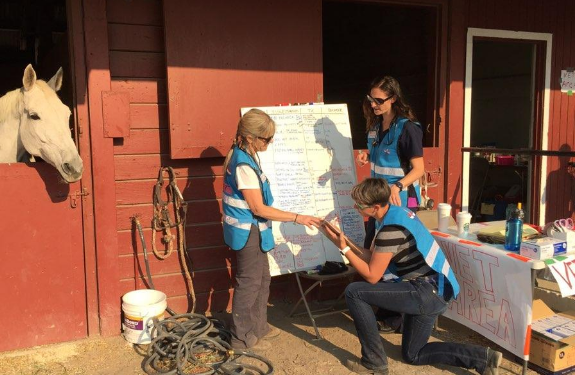Want to do something that saves lives, feels good and helps your community? Then volunteer to help animals when disasters strike in California!
Thousands of animals need care during and after disasters. Some 63% of California households have pets, including an estimated 10 million pet cats, nine million dogs, and one million horses. Other pets, farm animals, and wildlife also need assistance during and after disasters like earthquakes, floods, and wildfires.
Veterinary professionals are vital to animals during disasters. The mission of the California Veterinary Medical Reserve Corps (CAVMRC) is to preserve animal well-being and protect the public health and welfare by providing emergency veterinary medical care and expertise during the response phase of declared states of emergency.
Deployment is always voluntary. Volunteers get involved at whatever level works for them – assistants are needed as well as leaders, part-time responders are as welcome as those who can help out for a week or two, plus there are ongoing roles in areas such as planning and disaster response.
Volunteer participation can be a matter of life or death for rescued animals and means the world to the owners of those animals.

The CAVMRC provides veterinary professionals:
You don’t need any prior disaster response experience or training to join the CAVMRC. The entire veterinary practice team is welcome, including:
The CVMA registered the CAVMRC as a unit of the Medical Reserve Corps under the California Emergency Medical Services Agency and works in cooperation with local, statewide, and national agencies. The CVMA has played an important role in preparing for and responding to disasters in California since 1994 and builds on this experience with this new affiliation.
The CVMA registered the CAVMRC as a unit of the Medical Reserve Corps under the California Emergency Medical Services Agency and works in cooperation with local, statewide, and national agencies. The CVMA has played an important role in preparing for and responding to disasters in California since 1994 and builds on this experience with this new affiliation.
The CAVMRC program provides an opportunity for the entire veterinary practice team to participate, including:
Animal Control Officers and Shelter Staff working under the supervision of an in-house veterinarian. Members may be asked to submit evidence of education, licensing and certification for credentialing
When you become a member of the CAVMRC, the unit coordinator will create a profile for you on a secure website called the Disaster Healthcare Volunteers site. It is managed by the California Emergency Medical Services Authority. Included in your website profile is your contact information, which the CAVMRC can use to contact you in the event of a local or statewide disaster or emergency. The system is secure and your information is only seen by your unit coordinator. You will be granted access to your profile so that you may login to the website and update your information as needed. It is important to keep all of your contact information up to date in your web profile.
Required training:
The CAVMRC will direct new members to online self-guided, self-paced training modules presented by the Federal Emergency Management Agency (FEMA.) Each module takes about 30-45 minutes to read and ends with a quiz. When you pass, you will receive a Certificate of Completion. CAVMRC members are required to complete the following training to become regular unit members:
1. Incident Command System (IS-100) Classroom or FEMA Independent Study (online)
2. Incident Command System (IS-200) Classroom or FEMA Independent Study (online)
To join the CAVMRC, download the Quick Registration form, complete and email it to staff@cvma.net or fax at 916.646.9156. To receive additional information on the unit, training and registration, contact the CAVMRC Unit Coordinator at 916-649-0599.
Remember, free membership is extended to the entire veterinary practice team.